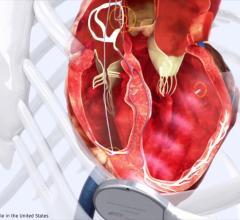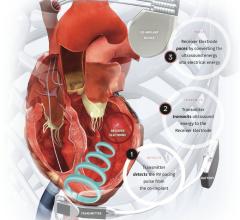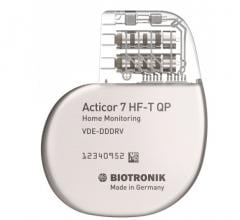April 17, 2015 — EBR Systems Inc. announced it has raised $20 million for clinical studies and regulatory filings, including commitments toward a second quarter closing. EBR Systems is using the funds to build on promising European clinical work; obtain CE Mark for the company’s proprietary wireless pacing system; obtain approval for a U.S. Investigational Device Exemption (IDE) clinical study; and complete development of its second generation system that is smaller and more energy efficient.
Watch the VIDEO “How to Implant a Leadless CRT LV Pacing System.”
The main focus is clinical work demonstrating product safety and effectiveness in heart failure patients who have not responded to conventional cardiac resynchronization therapy (CRT). Conventional CRT devices can improve left ventricular function and reduce morbidity and mortality in patients with cardiac synchronization problems. However, wires used to deliver pacing pulses to the left ventricle can break or otherwise fail, leading to complications in roughly 12 percent of cases.
In addition, approximately 30 percent of patients receiving conventional CRT do not respond to the therapy. A major reason is limitations on where wire leads can be placed in the heart’s venous anatomy. EBR’s wireless technology eliminates the need for leads and lets the physician place the endocardial technology at the most optimal site inside the left ventricle where it can be most effective. Data from multiple sources strongly suggests this can benefit patients and is a major advance in left ventricular stimulation.
Led by Thomas Fogarty, M.D., and Emergent Medical Partners, the financing includes current venture investors Split Rock Partners, SV Life Sciences, Delphi Ventures and St. Paul Venture Capital. In addition to institutional and private investors, the financing included participation by a cardiovascular corporate strategic investor. Private investors participating in this financing include Fogarty and Stephen Mahle, former president of Medtronic’s Cardiac Rhythm Management division, among others.
“I’ve been a physician for 55 years and am confident EBR Systems’ wireless technology is the future of cardiac pacing,” said Fogarty. “Wireless pacing enables stimulation of any site inside the heart. That degree of precision and flexibility is a huge advantage over lead-based systems requiring wires. Numerous studies make it clear that the decades-old approach of wired leads has many limitations.
“This technology also has huge potential implications for bradycardia, which is an abnormally slow heart rate. We can finally stimulate the left ventricle — which is the best location — instead of settling for the right ventricle. All the data we’ve seen indicates this can be a significant advance in treatment.”
David Milne, managing partner of SV Life Sciences, said, “Nearly $3.5 billion dollars are spent annually on CRT devices worldwide. Unfortunately, roughly one-third of the procedures fail to provide the patient with any benefit. That’s more than 1 billion dollars of devices wasted each year, with a lot of patients getting zero benefit. EBR Systems’ technology may dramatically change that by offering potentially superior efficacy, dramatic cost savings, and hope for patients who have previously failed conventional therapy.”
Read the article “Leadless Endocardial CRT Pacing Effective for Heart Failure Patients.”
For more information: www.ebrsystemsinc.com


 April 25, 2025
April 25, 2025 








